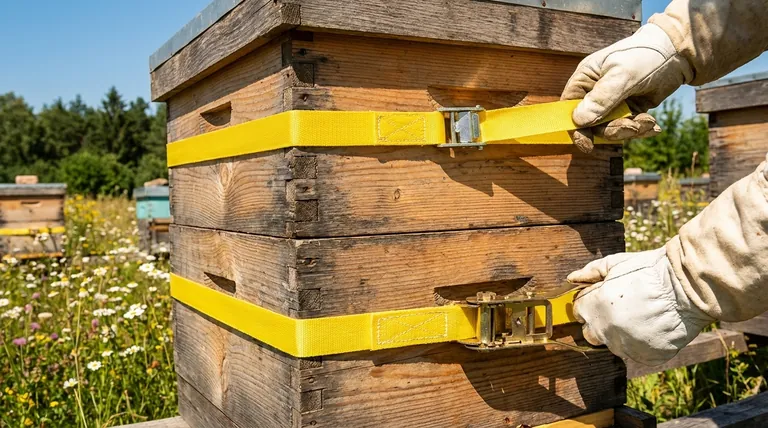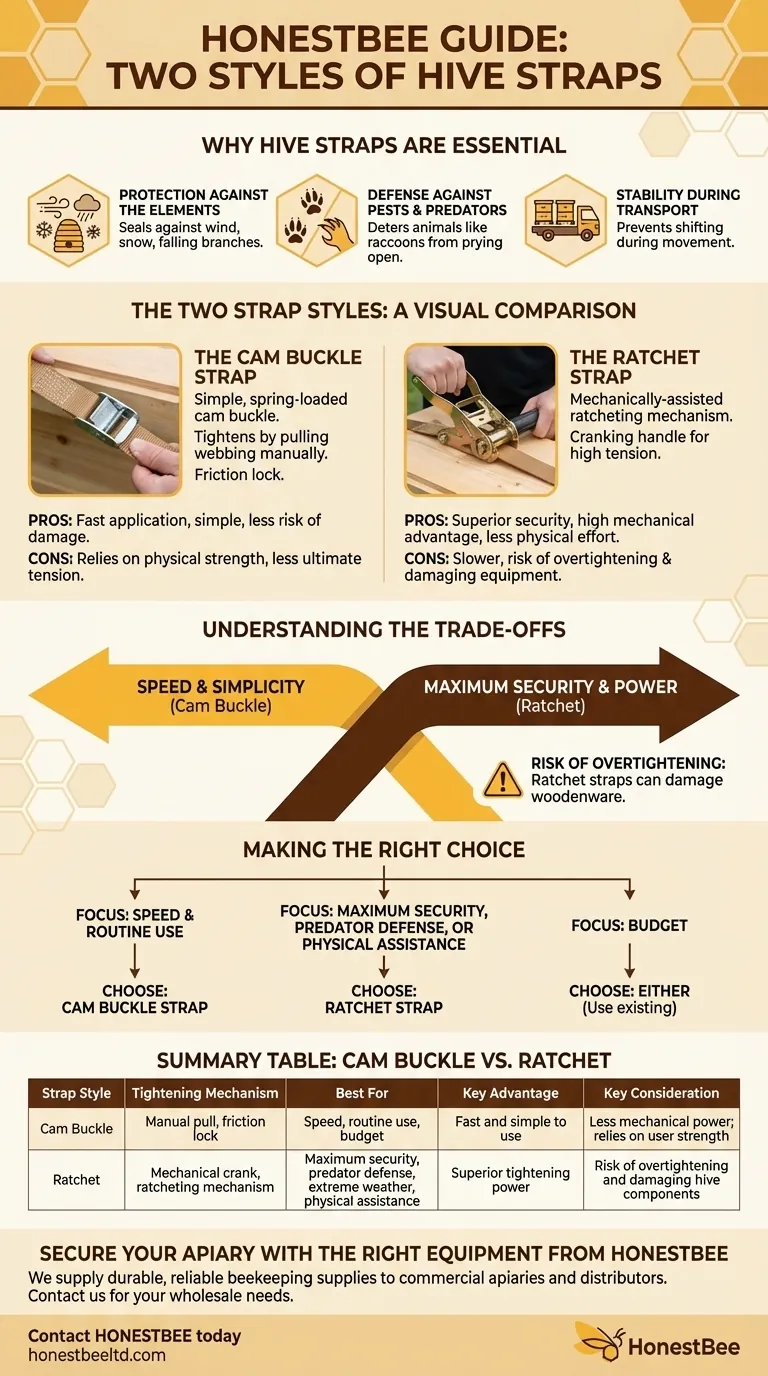Ultimately, hive straps come in two primary styles defined by their tightening mechanism: the simple cam buckle strap and the mechanically-assisted ratchet strap. Both are designed to securely fasten the components of a beehive together, but they achieve this tension in different ways.
Your choice between a cam buckle and a ratchet strap isn't about which one is "better," but which tool is right for the specific job. The decision balances simplicity and speed against mechanical power and ultimate security.

Why Hive Straps are an Essential Tool
Before comparing the styles, it's crucial to understand their purpose. A hive strap is a low-cost insurance policy that protects the colony from external forces that could break the hive's propolis seal and expose it.
Protection Against the Elements
Strong winds, falling branches, or heavy snow loads can shift or topple hive boxes. A strap ensures the hive body, supers, and covers remain a single, sealed unit, protecting the colony from disastrous exposure, especially during winter.
Defense Against Pests and Predators
Animals like raccoons are notorious for trying to pry open hives to access honey and brood. A tightly cinched strap is often a sufficient deterrent to prevent them from separating the hive boxes.
Stability During Transport
For beekeepers who move their hives for pollination or to different apiary locations, a strap is non-negotiable. It prevents the components from shifting or separating during the bumps and vibrations of travel.
A Closer Look at the Two Strap Styles
The fundamental difference between the two styles is how you apply and lock in the tension on the strap.
The Cam Buckle Strap
This style uses a simple, spring-loaded cam buckle. To tighten, you pull the loose end of the webbing through the buckle until it is taut. The teeth on the cam grip the strap, using friction to prevent it from slipping backward.
It is fast, straightforward, and requires only your own strength to pull it tight.
The Ratchet Strap
This design features a ratcheting mechanism that provides a significant mechanical advantage. After threading the strap, you crank a handle back and forth, which winds the webbing around a spool and tightens it far more than you could by hand alone.
This allows for exceptionally high tension, ensuring the hive components are locked together with immense force.
Understanding the Trade-offs
Neither strap is universally superior; they represent a classic trade-off between simplicity and power.
Speed vs. Security
Cam buckles are significantly faster to apply and release. For quick checks or minor adjustments, their simplicity is a major advantage.
Ratchet straps offer unparalleled security. If your primary concern is preventing a bear from entry or bracing for a hurricane, the tension from a ratchet strap is superior.
The Risk of Overtightening
The mechanical advantage of a ratchet strap is also its primary risk. It is very easy to overtighten the strap and potentially damage or warp your woodenware, crush comb, or even break frames. This requires a more measured approach.
A cam buckle, tightened only by hand, is much less likely to cause this kind of damage.
Physical Strength as a Factor
If you have limited grip strength or find it difficult to pull a cam buckle sufficiently tight, the ratchet strap is the clear choice. Its mechanical assistance does the heavy work for you.
Making the Right Choice for Your Apiary
Ultimately, many experienced beekeepers have both types on hand. However, if you are choosing one, your decision should be guided by your specific needs and priorities.
- If your primary focus is speed and routine use: The cam buckle strap is faster and simpler for everyday tasks and provides adequate security for most situations.
- If your primary focus is maximum security or physical assistance: The ratchet strap provides superior tightening power for predator defense, extreme weather, or if you need mechanical help to get a tight fit.
- If your primary focus is budget: Use what you already have. Both strap types perform their core function satisfactorily and are inexpensive to acquire.
Choosing the right strap is a small but important step in safeguarding the health and integrity of your colony.
Summary Table:
| Strap Style | Tightening Mechanism | Best For | Key Advantage | Key Consideration |
|---|---|---|---|---|
| Cam Buckle | Manual pull, friction lock | Speed, routine use, budget | Fast and simple to use | Less mechanical power; relies on user strength |
| Ratchet | Mechanical crank, ratcheting mechanism | Maximum security, predator defense, extreme weather, physical assistance | Superior tightening power | Risk of overtightening and damaging hive components |
Secure Your Apiary with the Right Equipment from HONESTBEE
Choosing the correct hive strap is a critical step in protecting your investment. Whether you manage a few backyard hives or a large commercial apiary, having the right tools on hand is essential for colony health and productivity.
At HONESTBEE, we supply durable, reliable beekeeping supplies and equipment to commercial apiaries and distributors through our wholesale-focused operations. We understand the demands of large-scale beekeeping and provide the gear you need to succeed.
Let us help you equip your operation for maximum security and efficiency.
Contact HONESTBEE today to discuss your wholesale needs and discover how our products can benefit your business.
Visual Guide

Related Products
- Professional Galvanized Hive Strap with Secure Locking Buckle for Beekeeping
- Wholesales Dadant Size Wooden Bee Hives for Beekeeping
- Professional Engraved Round Hive Number Tags for Beekeeping
- Reusable Clear Small Hive Beetle Traps for Beehives Beetle Trapping Tools
- Black Plastic Beetle Barn Hive Beetle Trap for Beehives
People Also Ask
- What are the types of Emlocks available? Choose the Right Strap for Hive Security
- What maintenance is required for hive straps? A Guide to Cam Buckle vs. Ratchet Strap Care
- What is the best length for straps used around beehives? Why 12 Feet is the Industry Standard
- What is the advantage of using cam buckle straps? Secure Your Load Fast with Simple, Safe Tensioning
- Why are hive straps important for beekeepers? Secure Your Hives Against Wind, Predators & Transport



















